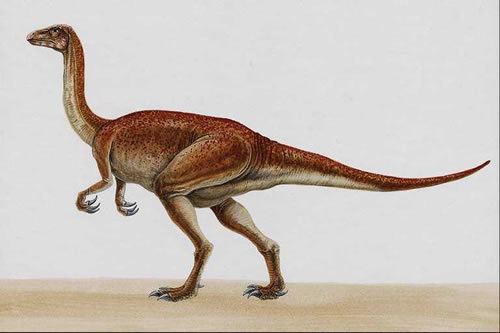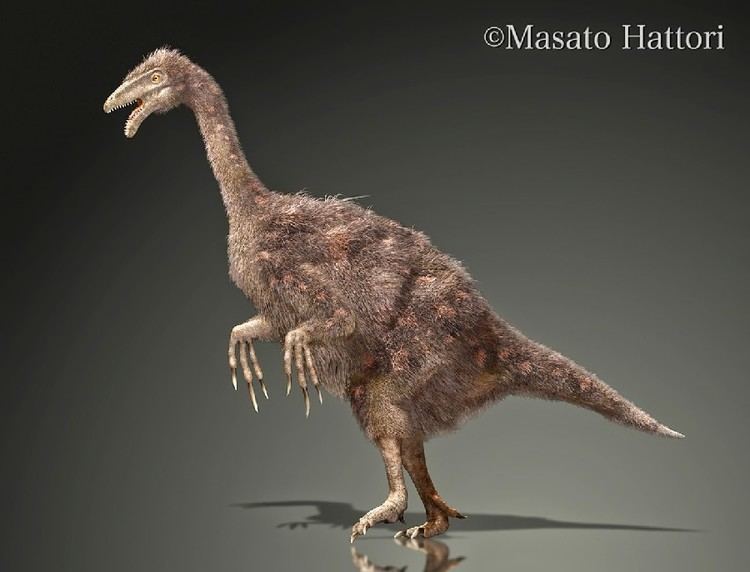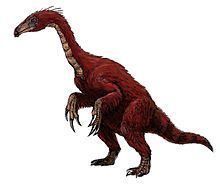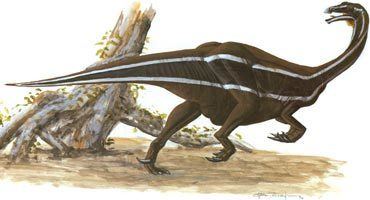Kingdom Animalia Clade Dinosauria Family †Therizinosauridae Phylum Chordata Order Saurischia | Class Reptilia Suborder Theropoda Species †S. galbinensis Rank Genus | |
 | ||
Similar Erlikosaurus, Therizinosauridae, Alxasaurus, Therizinosaur, Nanshiungosaurus | ||
Segnosaurus ('slow lizard') is a genus of herbivorous theropod dinosaur belonging to the Therizinosauridae from the Cretaceous of Mongolia.
Contents
- Segnosaurus vs therizinosaurus jurassic world the game
- Description
- Mandibles
- History of discovery
- Classification
- Paleobiology
- References

Segnosaurus vs therizinosaurus jurassic world the game
Description

Segnosaurus was a rather large therizinosaurid. In 2010 Gregory S. Paul estimated the body length at 6 metres (19.5 ft), the weight at 1.3 tonnes. Segnosaurus had an elongated head, large clawed hands, a somewhat elevated torso, a broad strong pelvis, stocky legs and a short tail.

Segnosaurus can be distinguished from all other therizinosaurs on the basis of two unique derived traits (autapomorphies). The in total forty-eight mandibular teeth are markedly peg-like and only slightly recurved: the front or mesial edge is curved and the back or distal edge is straight. The second autapomorphy is that the claws of the hand are rather flat instead of very narrow. In the same formation the closely related Erlikosaurus is found; Segnosaurus can be distinguished from this species by its moderate transverse compression of the pedal unguals or foot claws. Also the latero-dorsal shelf on the dentary, a flat bone surface at the upper outside of the lower jaw, starts at the fourteenth dentary tooth position and runs backwards for half the length of the lower jaw, unlike the shelf in Erlikosaurus, which starts at the fifth tooth position. This would have indicated that Segnosaurus did not have as extensive 'cheeks' as Erlikosaurus is believed to have had.
Mandibles

Both mandibles of Segnosaurus are known, missing only small portions of the posterior bones, and the entire angular bone. The dentary is very complez compared to other therizinosaurs, with the strongest downwards curve in the anterior end of any known therizinosaur. The front 25.5 mm (1.00 in) of this curve is edentulous (toothless), which is 8% more than in Erlikosaurus. A toothless portion of the mandible is near absent in Jianchangosaurus, and present but unknown in percentage in Beipiaosaurus and Neimongosaurus. When articulated the mandibles form a U-shaped curve like in Erlikosaurus and Neimongosaurus.
History of discovery
In 1973, a Soviet-Mongolian expedition at the Amtgay locality, 70 km (43 mi) northeast of Khan-Bogdsomona uncovered the fossil of a dinosaur. Through 1974 and 1975 more remains of the same taxon were uncovered at Amtgay and Khara-Khutul. The bones were relatively well preserved, and many regions of the skeleton were uncovered. These fossils were described in 1979 by Altangerel Perle, who described them as the new binomial Segnosaurus galbiensis. The generic name is derived from the Latin word segnis, meaning "slow" or "stocky", and the Ancient Greek sauros, meaning "lizard", because of the massive build of the animal. The specific name name refers to the Galbin region of the Gobi desert, where the fossils were found. In his 1979 description of Segnosaurus, Perle noted that the unique suite of features present were probably representative of a new family, which he named Segnosauridae, and he also noted that the family could only tentatively be classified as a theropod.
Both the holotype specimen and two additional specimens were originally referred to Segnosaurus. The holotype, stored at the Mongolian Academy of Sciences (GIN) under the accession number 100/80, includes both mandibles (lower jaws), an incomplete humerus, a complete radius and ulna, several phalanges and unguals (hand bones), an almost complete pelvis, an incomplete right femur, 6 sacral vertebrae, 25 caudal vertebrae, the first abdominal rib, and several other rib fragments. The second specimen, the paratype GIN 100/82, a femur, tibia, fibula, several tarsals, pedal phalanges and a claw (foot bones), rib fragments, complete ilia, the proximal portion of an ischium and the distal portion of a pubis. The third referred skeleton of that time (GIN 100/83), includes a fused scapula and coracoid, a radius, ulna, and separate arm bones. The next year in 1980, another specimen was referred to Segnosaurus by Rinchen Barsbold and Perle, GIN 100/81, which included a right tibia and fibula.
The four specimens were recovered from the Bayan Shireh Formation of the Mongolian People's Republic, in sediments dated between the Cenomanian to Turonian stages (Late Cretaceous Period, about 93 million years old).
Classification
Perle in 1979 assigned Segnosaurus to the Segnosauridae. The next year, in a description of the new taxon Erlikosaurus, Barsbold & Perle named the new order for the family, Segnosauria. At the time, the only two known genera were Segnosaurus and Erlikosaurus. At that point it also became clear that Therizinosaurus was a close relative and the group therefore actually was called the Therizinosauridae, a name having priority, and that these forms were plant-eaters instead of fish-eaters as had originally been presumed by Perle.
The following cladogram is based on the phylogenetic analysis by Phil Senter et al., 2012.
Paleobiology
Therizinosaurs are generally accepted to be omnivorous or herbivorous, showing herbivorous features like elongated necks, reduced skull size, broadening of the pelvis cavity, reduced bite force, reduced skull musculature, anterior tooth loss, development of a rhamphotheca, and a downturned anterior portion of the dentary, all of which are present, or presumed to be present in Segnosaurus. However, there has been no complexity in tooth morphology, which is found in many other herbivorous groups. A few of the dental modifications include increased symmetry in Erlikosaurus, enlargement of denticles in Segnosaurus, with the only previously known unique tooth morphologies being the cusped, incisiform anterior teeth of Falcarius and the outwards convex teeth of Jianchangosaurus.
However, in a 2016 study on the holotype dentaries of Segnosaurus, an additional tooth morphology was identified. One of these modifications is the presence of an additional row of denticles on the lateral side of posterior teeth, the other being a denticulated facet on the distal tooth crown, which shows that Segnosaurus had unique dental features within Theropoda, and a higher degree of oral food processing compared to other known therizinosaurids where teeth are known. This supports the idea that therizinosaurs were dietary-partitioned, which is also based on the very high number of therizinosaurs present in the same formations, and the highly varying bodymass (500% difference in mass in the Bayan shireh formation).
